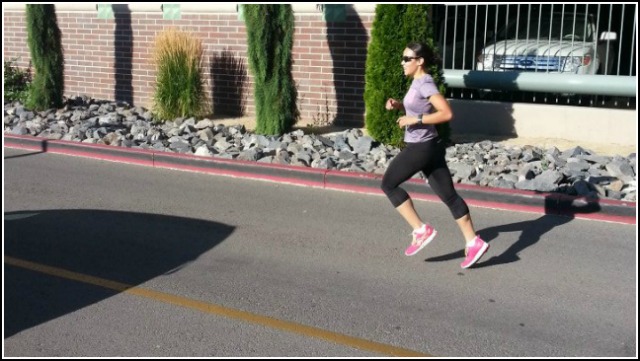Running injuries can seem common – maybe even inevitable. Whether you’re a new runner or a veteran, they’re a frustrating part of our beloved sport.

And there’s a never-ending list of injuries that you might experience:
- Hamstring strains
- Posterior tibial tendinitis
- Calf and ankle injuries
- Back pain
- Plantar fasciitis
- Iliotibial band syndrome
But could anyone possibly be unlucky enough to have every one of these injuries, all in the course of 2 years?
Unfortunately, yes. Meet Lynsey.

She experienced every single injury on that lengthy list – some more than once. Her doctor was even discouraged enough that he finally told her “Maybe you’re not cut out for running.”
Hearing that from a medical professional is enough to make most runners reconsider their options! Fortunately, Lynsey ignored him.
“I was doing everything right…”
Lynsey started running about three years ago – but she only stayed healthy for one year. Soon, the frustration mounted:
I read every book and website to find out how to beat the injuries. I was so incredibly frustrated.
My first year of running was incredible but since then, I hadn’t improved much because I couldn’t make it through one training cycle without getting injured.
Before Strength Running, Lynsey regularly followed training plans she found either online or in a book. She also frequently used the Maffetone Method.
The Maffetone Method is often used in the base phase of training. The goal is to gradually improve aerobic fitness by running under a certain heart rate threshold.
But while easy running builds a great foundation, it’s an incomplete training method. Even base fitness requires some fast running.
And every time Lynsey tried to run faster she got hurt. Every few weeks, she’d experience another setback that would crush her consistency.
She felt like she was doing everything right:
I never increased my mileage too quickly, I lifted weights regularly, I foam rolled, I ran easy on easy days and hard on hard days, I got shoes fit for my type of gait, etc. I was doing everything right. I couldn’t understand why I kept getting injured.
With a big goal race on her schedule, she was out of ideas and feeling desperate.
Then she came across Strength Running, spent three hours devouring all of the injury prevention material and remembered,
I felt like everything on there was speaking directly to me.
Although she was hesitant to pay for a custom training plan, Lynsey decided that she had no other option.
It was more than I would have liked to pay, but then, if you add up all of the books and physical therapy costs I’ve spent last year alone. I realized if this plan worked, it would actually be a bargain.
But, did it work?
“They Laughed In My Face…”
When she started using her new training, she was 100% committed to the new system. Much of it was different for her:
- She actually ran fewer days per week than before
- Her easy pace was slower
- She sandwiched her runs with a dynamic warm-up and a runner-specific strength routine
- Mileage increases were more gradual
The result? She was unconvinced that she would be able to run a strong marathon!
Adapting to the plan was a tough process for Lynsey. She questioned many aspects of it, and deep down remained convinced that she would be that one runner who wasn’t a success story.
Lynsey also admits that she was challenged by the added strength work after runs and the slower running paces.
I was given a range of paces for my easy, tempo and race pace runs. Which were all slower than I had previously been running.
Slowing down was tough. I was only running about 20 seconds per mile faster before the plan, but that 20 seconds was enough for me to be completely alone during a group run.
In addition to doubting her own ability, runners in her training group were certain she wasn’t training correctly:
When I told them about my plan, they basically laughed in my face and said that I should be running 20 miles by then.
No wonder Lynsey questioned if she was doing the right thing!
Amazingly, she stuck with it. She reminded herself that the definition of insanity is doing the same thing repeatedly but expecting different results.
And as she remembers:
I’d done the same training over and over again thinking I wouldn’t get injured and I was tired of being insane.
Dedication Pays Off!

Lynsey used a personal 20-week training plan that I built to her unique fitness level, goals, schedule, injury background, and other areas. Despite her doubts (and those of her running friends), she continued to follow every aspect of it week after week.
And in the final month of her plan, she suddenly realized something: she had yet to feel any hint of injury!
After 2 years of struggle, Lynsey was finally able to run consistently. And as we know, consistency is the secret sauce to improvement.
When you’re stuck in a chronic injury cycle, unable to get in weeks and months of consistent training, it becomes impossible to improve. But with consistent running, goals that looked out of reach suddenly become attainable.
A focus on injury prevention always pays off.
When race day arrived, Lynsey knew she was ready. And she was: not only did she set a personal record by more than three and a half minutes, but she finished feeling amazingly strong.
I ran the strongest race of my life. Prior to the plan, I had run 3 half marathons and felt defeated at the end of every single run.
Not only did I PR, but I think I could have actually run it faster had I not been so concerned with going out too fast and dying in the end.
I guess I didn’t realize how strong the plan had made me.
Even more exciting than her PR was Lynsey’s new outlook on her future running. Suddenly, a whole range of options opened up for her:
One of my goals has been to run a marathon and then maybe a 50k. I remember telling my friends as I crossed the finish line of each half marathon that I could never imagine saying “ok, halfway there.”
I felt amazing for most the race. I even remember thinking around mile 9 that I was being too modest with my effort because it felt too easy.
That “easy effort” was about 25 seconds per mile faster than a 10k I had ran 7 months prior. I couldn’t believe it.
And best of all, when I crossed that finish line, I knew without a doubt I could finish a marathon. And not just finish it, but finish strong!
Lynsey had faced more injuries in 2 years than most of us face throughout our entire running career. And she was slow to trust in the approach of her new training plan.
But her success speaks for itself.
How to Run Like Lynsey
Running faster than you ever have before often means training differently than you ever have before.
The fundamentals are critical. Here is what made Lynsey successful:
- She ran appropriate training paces, which often felt “too slow” on her easy days
- She warmed up properly before every run
- After each run she did a runner-specific strength or core workout
- She ran fewer days, but slightly higher overall mileage
- Her workouts became more strategic and appropriate for her ability
Each of these training improvements provides a small benefit. But when they’re added together, you get healthy, consistent running and faster race times!
If you believe that you’re not cut out for running, this story should make you think twice.
Even Lynsey told me:
This plan changed my belief. I started to believe what others had said, that maybe I wasn’t cut out for running because I was always getting injured.
Can you imagine if Lynsey had settled? If she had believed her doctor that she wasn’t made to be a runner? Or her friends that she wasn’t training correctly?
She would be right where she started: frustrated, injured, and feeling helpless. But I’m thankful she believed in herself instead!
The Power of Personalized Training
Lynsey is now a firm believer in intelligently designed training with a focus on the fundamentals.
By the end of this plan, I had ran the longest long run I have ever ran (twice), the most miles I have ever ran in one week, and I ran consistently, never missing a single training day (because of injury) for 5 months straight.
Running injury free, without even a hint of pain for an entire training cycle was an amazing accomplishment.
Lynsey believes that custom training plans are successful because of their simplicity and specificity. They avoid over-complicating running while at the same time staying true to the needs of the individual runner.
Training plans that are “one size fits all” will never be equally effective. She is unequivocal in her recommendation:
I would absolutely without a doubt recommend a PR Race Plan for someone who was just like me.
Lynsey’s renewed enthusiasm for running is even more inspiring:
I feel like I have finally just reached the tip of the iceberg when it comes to running. I’m ready to take the tools I’ve learned from this plan and move on to more consistent running and more PRs.
And those PRs are hers for the taking!
If you’d like to see how much faster you could race with a custom plan, learn more about the PR Race Plan here.
More interested in injury prevention? Get our free email course here.
Run strong!